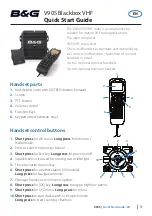
AUTO
MANUAL
CODE
LEVEL
NCV
AUTO
MANUAL
8
1
2
4
5
6
7
10 11
SIGNAL
3
9
1
3
4
8
5
7
6
9
10
11
2
CODE
SIGNAL
CODE
SIGNAL
♦
1.3.3 Sketch of receiver
①
②
Probehead
③
LCD screen
④
Power on-off key
⑤
Key for adjusting sensitivity up under
manual mode.
⑥
Key for adjusting sensitivity down under
manual mode.
⑦
Key fo turning on/off the flashlight.
⑧
NCV
⑨
MANUAL key for switchover between manual
and automatic cable locating.
⑩
Mute
Backlight
Flashlight.
♦
1.3.4 Receiver display
①
receiver's battery.
②
Symbol to indicate mains voltage.
③
Singal value when detecting cable.
④
Code received.
⑤
Intensity of signals when detecting cable
or AC detecting.
⑥
Signal inrtensity level received.
⑦
Symbol to indicate mute mode.
⑧
Received sensitivity under Manual mode.
⑨
Manual mode
⑩
Automatic mode
NCV
Symbol to indicate voltage/energy of the
♦
1.3.5 Display of receiver under cable locating mode
(1) Automatic mode
(2) Manual mode
(3) Mains voltage
identification mode
2. CARRYING OUT MEASUREMENT
05
06
2.1 Measurement Precautions
1.As the connection of the transmitter with the mains supply may generate circuit current
of milliampere level, in live condition the Grounding hole of the transmitter can be only
connected with a neutral conductor. If transmitter connection is realized from the phase
towards the protective conductor, the functional safety of the protective conductor must
be tested first, in compliance with DIN VDE 0100.
The reason is that when connecting the transmitter from phase towards ground, all parts
being connected to the earth may be live in the event of an error (if the earth resistance
does not comply with the prescriptions).
2.When the transmitter is connected with live mains, if the Grounding hole of the
transmitter is connected with protective ground phase, the current leakage (if any) in the
power supply line may join the circuit current of the transmitter, leading to tripping of
the leakage circuit breaker, i.e. tripping of FI/RCD.
1.When use the transmitter as a voltage tester to test the mains voltage,it will have weak
spark at the moment the probes touch the mains voltage, this is normal phenomenon.
2.If any one of the “Start/Stop” key, the “Code Set” key and the "Level Set” key is
effective, the other two are ineffective.
2.2 Functional principle
This Cable Locator consists of a transmitter, a receiver and some accessories.
The transmitter sends to the target cable (or metal pipes) an AC voltage modulated by
digital signals, which generates an alternating electric field (see Fig. 2-1); Put the probe
of the receiver close to this electric field, and the sensor will generate induced voltage.
This instrument can magnify this weak voltage signal by hundreds of times and then
display it via LCD screen after digital processing, so that the position of the buried
cables or pipes, as well as their faults, can be detected based on the change of the signal.
1.For any application, the connections of the transmitter should ensure a closed circuit.
2.This Cable Locator can only detect or locate lines correctly connected pursuant to the
physical principle described.
CAUTIONS
HINTS
WARNING
Your excellent helper in measuring instruments
.
Your excellent helper in measuring instruments
.


































